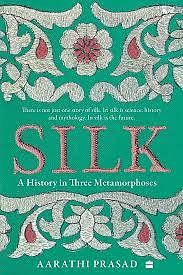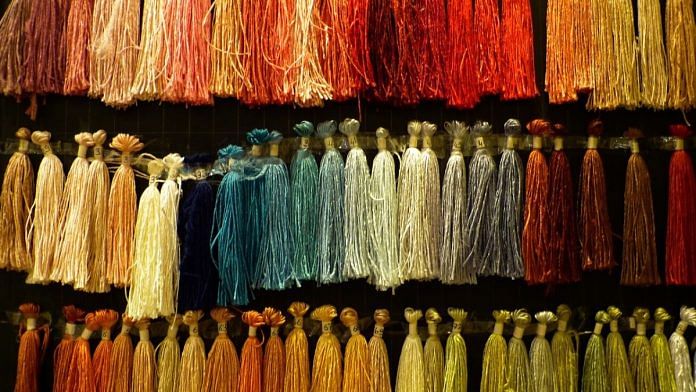Ministers of Adolf Hitler’s Third Reich came together to find a solution to some of the challenges presented by the modern theatre of war. That solution was not extermination, but breeding; not of Übermenschen, but of Bombyx mori. The docile and pliable silkworms would now become wartime animals, allies in a new era of silk cultivation.
At the same moment that Churchill steeled Britain’s air force to wage war in the skies, Hitler recruited silkworms to the Nazi aerial warfare effort, for the production of parachutes. The silken fabrics made of their threads were not just lightweight, tear-resistant and water-repellent, they were largely fireproof as well. For the cultivation of Bombyx mori, millions of mulberry trees were planted along roadsides and railways, in cemeteries and schools.
Teachers trained to make silk suspended their cocoons over cauldrons of boiling water. They used them in experiments, dissected for the children’s biological education. By return, students fed and attended to the silkworms. The little caterpillars were weaponized as instruments of biological instruction of ‘racial hygiene’. It was easy to grasp. Even a child could successfully breed healthy silkworms, so long as all those that were weak, or sick, were removed and destroyed as soon as they were identified.
Also read:
Bombyx mori, inbred for millennia – or, in other words, pure of race − failed the test of Nazi eugenic fitness. Still, the scale of their industrialized programme of silk production meant that thousands of silken parachutes were made. On 20 May 1941, on the island of Crete, one of the war’s great theatres of combat, two thousand of these parachutes darkened the skies. After Hitler’s soldiers massacred and burned, and were finally beaten, the women of the island, who cultivated silk of their own, cut up those parachutes and worked them into handkerchiefs. And then, just as the Bombyx had been, the spider was unwittingly recruited to military service, too.
The peculiarities of its silk in particular were needed, not for parachutes, but for something far more precise. Astronomers had long used a single strand of spider’s silk gathered in much the same way as François Xavier Bon de Saint Hilaire had, and from around the same time. Placed as crosshairs inside telescopes, these threads were a blessing for their consistency of thickness, being as good as weightless but almost impossible to break. Just such a thread had fixed the problem that in 1782 the celebrated astronomer William Herschel had found with its main competitor.
Through the eyepiece of a telescope, ‘the single threads of the silkworm’ became, he found, ‘so much magnified that their diameter is much more than that of many of the stars’. More than that, Bombyx mori silk fibres are triangular in form, and while that triangular, prism-like structure allows silk cloth to refract incoming light, endowing it with exactly the shimmering appearance that made it famous as a textile, it did not work at all well in viewfinders. Nor would the threads of the wild Antheraea silk moths have, for they are flat and ribbon-like. But spider’s silk is round, and, when drawn out by a spider, has a given, controlled diameter that remains constant over lengths that span metres. And that was the sort of consistency needed for crosshairs: reliably sized, extremely fine and yet tough enough to be handled. That was why spider’s threads, in contrast to other silks – or hair of any description – allowed a clear line of sight so that the angles of stars and the distances between them might be measured with precision, and yet, somehow, remained fine enough not to obscure the line of sight.
Two hundred and sixty years after Herschel, the war that enveloped Europe meant that spider silk would be sought again, this time not by astronomers but to fulfil the need for crosshairs of bombsights, gunsights, telescopes and microscopes that would give armed forces far-reaching capabilities, which, in turn, rendered the spider indispensable for fine markings and sight lines. Military precision required silk that was either 1/10,000th of an inch in diameter – some ten times thinner than a human hair – or even far finer than that. In 1939, this call to arms with a spider’s web was answered by a woman born in Tennessee fifty years after Burt Green Wilder had started life in that same state before eventually ending up in California.
There, Nannie ‘Nan’ Songer raised two children, enrolled in biology classes at the University of California, and then put aside her childhood collection of arachnids for a house full of black widow spiders and other large species that crossed her path from then on. Songer’s spiders would be glorified as war-working spiders, spiders that toiled and spun for national defence. To encourage them, she devised a technique that would once again be hailed as novel, but was by now nearly two hundred years old: pinning the spiders belly-up onto a piece of cork, tickling their spinnerets until silk emerged, collecting those strands with a fine hook and then wrapping those threads onto a frame.
But Songer’s efforts succeeded where Termeyer, Bon and Camboué ultimately came unstuck. She counted among her clients the government of the United States of America. The couriers who collected the reams of silk from her home handcuffed briefcases containing the precious cargo to their wrists so that they could not be stolen. Nan Songer’s products were precious. By the end, using week-old spiders and magnifying lenses made to her own specifications, she had managed to collect from her little protégés threads that seemed barely even there, 1/500,000th of an inch thick, and yet that she still found to be ‘possibly one of the strongest materials made by a living creature’.
When the lips of Hitler and his officers pressed down onto the thin glass vials of cyanide they’d kept close at hand and the battles of the Second World War had ceased, instead of the military, Songer’s spider silk supplied the finest of crosshairs for the telescopes in which their use had begun, as well as microscopes and medical instruments. Showing that the threads of the spider might help to heal as well as they had helped to kill.
 This excerpt from Aarathi Prasad’s ‘Silk: A History in Three Metamorphoses’ has been published with permission from HarperCollins India.
This excerpt from Aarathi Prasad’s ‘Silk: A History in Three Metamorphoses’ has been published with permission from HarperCollins India.



